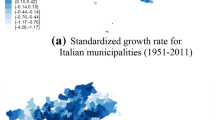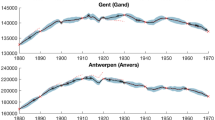Abstract
This paper analyses the growth of American cities, understood as the growth of the population or of the per capita income, from 1990 to 2000. This empirical analysis uses data from all the cities (incorporated places) with more than 25,000 inhabitants in the year 2000 (1,152 cities). The results show that while common convergence behaviour is observed in both population and per capita income growth, there are differences in the evolution of the distributions: the population distribution remains almost unchanged, while the per capita income distribution makes a great movement to the right. We use two different methodologies to test cross-sectional convergence across cities: linear growth models (allowing for spatial spillovers between locations) and spatial quantile regressions. We find evidence of significant spatial effects and nonlinear behaviour.





Similar content being viewed by others
Notes
A good commentary on the relationship between cities and national economic growth can be found in Polèse (2005).
See Le Gallo et al. (2003) for a similar exercise of spatial econometric analysis of convergence across European regions.
The US Census Bureau offers information on a large number of variables for different geographical levels, available on its website: www.census.gov.
The land area data also come from the US Census Bureau: http://www.census.gov/population/www/censusdata/places.html and http://www.census.gov/geo/www/gazetteer/places2k.html.
These data are the 30-year average values computed from the data recorded during the period 1971–2000. Source: U.S. National Oceanic and Atmospheric Administration (NOAA), National Climatic Data Center (NCDC), Climatography of the United States, Number 81 (http://cdo.ncdc.noaa.gov/cgi-bin/climatenormals/climatenormals.pl).
We also introduce state-level dummies into some of the preliminary estimations, but most of them are not significant and the results are qualitatively the same.
Everything seems to indicate that this behaviour has persisted for decades. Figure 2 of Young et al. (2008), corresponding to the evolution of the distribution of US counties’ log per capita incomes from 1970 to 1998, presents a very similar effect to that observed in our estimated kernel of city per capita income distribution from 1989 to 1999.
Although there is a great deal of variability in the results reported in the literature, see the meta-analysis by Melo et al. (2009).
Fingleton and López-Bazo (2006) survey the literature on empirical growth models with spatial effects and conclude that most contributions focus their attention on the spatial lag and the spatial error models, neglecting the spatial cross-regressive specification.
Spatial coordinates (longitude and latitude in decimal degrees) data for the incorporated places are obtained from the US Census Bureau Gazetteer.
The spatial matrix was constructed using the SPATWMAT Stata command. The spatial regressions are estimated with the SPATDIAG and the SPATREG commands. All these tools for spatial data analysis using Stata were developed by Maurizio Pisati.
The inclusion of the spatial lag in these OLS regressions can cause an endogeneity issue. We will deal with this potential problem in the next section.
This is omitted because of data scarcity, although part of this variable could be captured by the city land area growth, which has already been included.
The spatial quantile regressions are estimated using the McSpatial R package developed by Daniel McMillen.
References
Anselin L (2001) Spatial econometrics. In: Baltagi BH (ed) A companion to theoretical econometrics. Blackwell, Oxford
Barro RJ, Sala-i-Martin X (1992) Convergence. J Polit Econ 100(2):223–251
Beaumont C, Ertur C, Le Gallo J (2003) Spatial convergence clubs and the European regional growth process, 1980–1995. In: Fingleton B (ed) European regional growth. Springer, Berlin, pp 131–158
Beeson PE, DeJong DN, Troesken W (2001) Population growth in US counties, 1840–1990. Reg Sci Urban Econ 31:669–699
Black D, Henderson V (1998) Urban evolution in the USA. Brown University working paper no. 98–21
Chasco C, López AM, Guillain R (2012) The influence of geography on the spatial agglomeration of production in the European Union. Spat Econ Anal 7(2):247–263
Duranton G (2000) Urbanization, urban structure, and growth. In: Huriot J-M, Thisse JF (eds) Economics of cities: theoretical perspectives. Cambridge University Press, Cambridge, pp 290–317
Duranton G, Puga D (2004) Micro-foundations of urban agglomeration economies. In: Henderson JV, Thisse JF (eds) Handbook of urban and regional economics, vol 4, chapter 48. Elsevier Science, Amsterdam, pp 2064–2117
Durlauf SN, Johnson PA (1995) Multiple regimes and cross-country growth behaviour. J Appl Econ 10:365–384
Evans P (1997) How fast do economies converge? Rev Econ Stat 79(2):219–225
Evans P, Karras G (1996a) Do economies converge? Evidence from a panel of U.S. states. Rev Econ Stat 78(3):384–388
Evans P, Karras G (1996b) Convergence revisited. J Monet Econ 37:249–265
Fingleton B, López-Bazo E (2006) Empirical growth models with spatial effects. Pap Reg Sci 85(2):177–198
Fujita M, Thisse J-F (2002) Economics of agglomeration. Cambridge University Press, Cambridge
Garicano L, Rossi-Hansberg E (2006) Organization and inequality in a knowledge economy. Q J Econ 121(4):1383–1435
Glaeser EL (2000) The new economics of urban and regional growth. In: Clark GL, Feldman MP, Gertler M (eds) The Oxford handbook of economic geography. Oxford University Press, Oxford, pp 83–98
Glaeser EL, Saiz A (2004) The rise of the skilled city. Brookings-Wharton Papers on Urban Affairs, pp 47–105
Glaeser EL, Shapiro J (2003) Urban growth in the 1990s: is city living back? J Reg Sci 43(1):139–165
Glaeser EL, Kallal HD, Scheinkman JA, Shleifer A (1992) Growth in cities. J Polit Econ 100(6):1126–1152
Glaeser EL, Scheinkman JA, Shleifer A (1995) Economic growth in a cross-section of cities. J Monet Econ 36:117–143
Glaeser EL, Kolko J, Saiz A (2001) Consumer city. J Econ Geogr 1(1):27–50
Heckelman JC (2013) Income convergence among U.S. states: cross-sectional and time series evidence. Can J Econ 46(3):1085–1109
Henderson V, Kuncoro A, Turner M (1995) Industrial development in cities. J Polit Econ 103(5):1067–1090
Higgins MJ, Levy D, Young AT (2006) Growth and convergence across the U.S.: evidence from county-level data. Rev Econ Stat 88(4):671–681
Ioannides YM, Overman HG (2004) Spatial evolution of the US urban system. J Econ Geogr 4(2):131–156
Jacobs J (1969) Economy of cities. Vintage, New York
Johnson PA, Takeyama LN (2001) Initial conditions and economic growth in the US states. European Econ Rev 45:919–927
Kim T-H, Muller C (2004) Two-stage quantile regression when the first stage is based on quantile regression. Econom J 7:218–231
Kostov P (2009) A spatial quantile regression hedonic model of agricultural land prices. Spat Econ Anal 4(1):53–72
Le Gallo J, Ertur C, Baumont C (2003) A spatial econometric analysis of convergence across European regions, 1980–1995. In: Fingleton B (ed) European regional growth. Springer, Berlin, pp 99–129
Loury GC (1979) Market structure and innovation. Q J Econ 93(3):395–410
Melo PC, Graham DJ, Noland RB (2009) A meta-analysis of estimates of urban agglomeration economies. Reg Sci Urban Econ 39:332–342
Mitchener KJ, McLean IW (2003) The productivity of US States since 1880. J Econ Growth 8:73–114
Plummer P, Sheppard E (2006) Geography matters: agency, structures and dynamics at the intersection of economics and geography. J Econ Geogr 6(5):619–637
Polèse M (2005) Cities and national economic growth: a reappraisal. Urban Stud 42(8):1429–1451
Puga D (2010) The magnitude and causes of agglomeration economies. J Reg Sci 50(1):203–219
Quigley JM (1998) Urban diversity and economic growth. J Econ Perspect 12(2):127–138
Rey SJ, Montouri BD (1999) US regional income convergence: a spatial econometric perspective. Reg Stud 33(2):143–156
Roback J (1982) Wages, rents, and the quality of life. J Polit Econ 90(6):1257–1278
Roos MWM (2005) How important is geography for agglomeration? J Econ Geogr 5:605–620
Rosenthal SS, Strange WC (2004) Evidence on the nature and sources of agglomeration economies. In: Henderson JV, Thisse JF (eds) Handbook of urban and regional economics, vol 4, chapter 49. Elsevier Science, Amsterdam, pp 2119–2171
Sala-i-Martin X (1996) Regional cohesion: evidence and theories of regional growth and convergence. Eur Econ Rev 40:1325–1352
Simon CJ, Nardinelli C (2002) Human capital and the rise of American Cities, 1900–1990. Reg Sci Urban Econ 32:59–96
Yamamoto D (2008) Scales of regional income disparities in the USA, 1955–2003. J Econ Geogr 8(1):79–103
Young AT, Higgins MJ, Levy D (2008) Sigma convergence versus beta convergence: evidence from U.S. County-level data. J Money Credit Bank 40(5):1083–1093
Zheng S, Fu Y, Liu H (2009) Demand for urban quality of living in China: evolution in compensating land-rent and wage-rate differentials. J Real Estate Financ Econ 38(3):194–213
Zheng S, Kahn ME, Liu H (2010) Towards a system of open cities in China: home prices, FDI flows and air quality in 35 major cities. Reg Sci Urban Econ 40:1–10
Zietz J, Zietz EN, Sirmans GS (2008) Determinants of house prices: a quantile regression approach. J Real Estate Financ Econ 37:317–333
Acknowledgments
The author acknowledges financial support from the Spanish Ministerio de Economía y Competitividad (ECO2013-45969-P and ECO2013-41310-R projects), the DGA (ADETRE research group), and FEDER. An earlier version of this paper was previously circulated under the title “What makes cities bigger and richer? New evidence from 1990–2000 in the US.”
Author information
Authors and Affiliations
Corresponding author
Rights and permissions
About this article
Cite this article
González-Val, R. Cross-sectional growth in US cities from 1990 to 2000. J Geogr Syst 17, 83–106 (2015). https://doi.org/10.1007/s10109-014-0204-0
Received:
Accepted:
Published:
Issue Date:
DOI: https://doi.org/10.1007/s10109-014-0204-0




